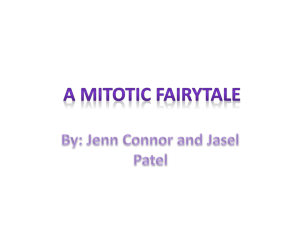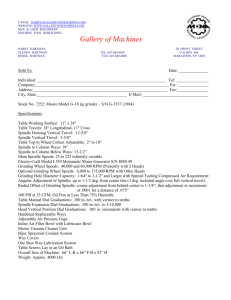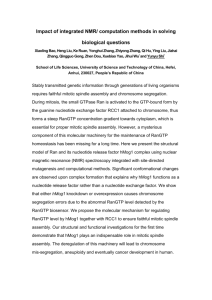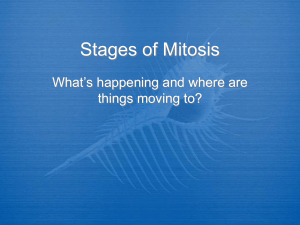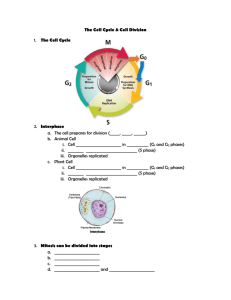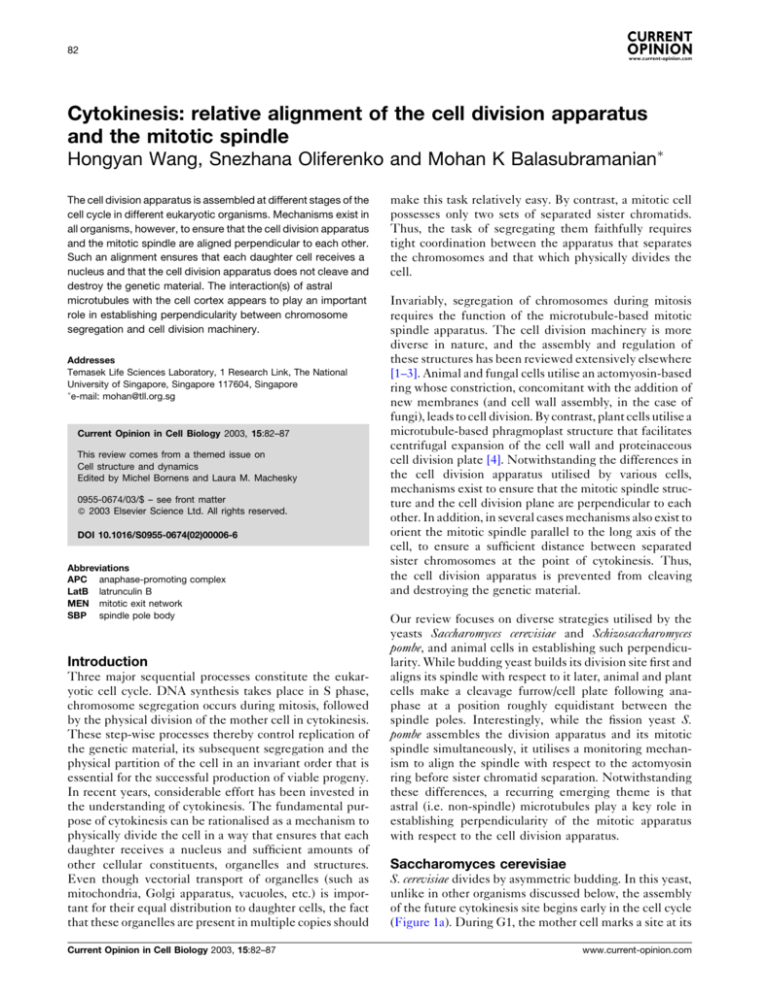
82
Cytokinesis: relative alignment of the cell division apparatus
and the mitotic spindle
Hongyan Wang, Snezhana Oliferenko and Mohan K Balasubramanian
The cell division apparatus is assembled at different stages of the
cell cycle in different eukaryotic organisms. Mechanisms exist in
all organisms, however, to ensure that the cell division apparatus
and the mitotic spindle are aligned perpendicular to each other.
Such an alignment ensures that each daughter cell receives a
nucleus and that the cell division apparatus does not cleave and
destroy the genetic material. The interaction(s) of astral
microtubules with the cell cortex appears to play an important
role in establishing perpendicularity between chromosome
segregation and cell division machinery.
Addresses
Temasek Life Sciences Laboratory, 1 Research Link, The National
University of Singapore, Singapore 117604, Singapore
e-mail: mohan@tll.org.sg
Current Opinion in Cell Biology 2003, 15:82±87
This review comes from a themed issue on
Cell structure and dynamics
Edited by Michel Bornens and Laura M. Machesky
0955-0674/03/$ ± see front matter
ß 2003 Elsevier Science Ltd. All rights reserved.
DOI 10.1016/S0955-0674(02)00006-6
Abbreviations
APC anaphase-promoting complex
LatB latrunculin B
MEN mitotic exit network
SBP spindle pole body
Introduction
Three major sequential processes constitute the eukaryotic cell cycle. DNA synthesis takes place in S phase,
chromosome segregation occurs during mitosis, followed
by the physical division of the mother cell in cytokinesis.
These step-wise processes thereby control replication of
the genetic material, its subsequent segregation and the
physical partition of the cell in an invariant order that is
essential for the successful production of viable progeny.
In recent years, considerable effort has been invested in
the understanding of cytokinesis. The fundamental purpose of cytokinesis can be rationalised as a mechanism to
physically divide the cell in a way that ensures that each
daughter receives a nucleus and suf®cient amounts of
other cellular constituents, organelles and structures.
Even though vectorial transport of organelles (such as
mitochondria, Golgi apparatus, vacuoles, etc.) is important for their equal distribution to daughter cells, the fact
that these organelles are present in multiple copies should
Current Opinion in Cell Biology 2003, 15:82±87
make this task relatively easy. By contrast, a mitotic cell
possesses only two sets of separated sister chromatids.
Thus, the task of segregating them faithfully requires
tight coordination between the apparatus that separates
the chromosomes and that which physically divides the
cell.
Invariably, segregation of chromosomes during mitosis
requires the function of the microtubule-based mitotic
spindle apparatus. The cell division machinery is more
diverse in nature, and the assembly and regulation of
these structures has been reviewed extensively elsewhere
[1±3]. Animal and fungal cells utilise an actomyosin-based
ring whose constriction, concomitant with the addition of
new membranes (and cell wall assembly, in the case of
fungi), leads to cell division. By contrast, plant cells utilise a
microtubule-based phragmoplast structure that facilitates
centrifugal expansion of the cell wall and proteinaceous
cell division plate [4]. Notwithstanding the differences in
the cell division apparatus utilised by various cells,
mechanisms exist to ensure that the mitotic spindle structure and the cell division plane are perpendicular to each
other. In addition, in several cases mechanisms also exist to
orient the mitotic spindle parallel to the long axis of the
cell, to ensure a suf®cient distance between separated
sister chromosomes at the point of cytokinesis. Thus,
the cell division apparatus is prevented from cleaving
and destroying the genetic material.
Our review focuses on diverse strategies utilised by the
yeasts Saccharomyces cerevisiae and Schizosaccharomyces
pombe, and animal cells in establishing such perpendicularity. While budding yeast builds its division site ®rst and
aligns its spindle with respect to it later, animal and plant
cells make a cleavage furrow/cell plate following anaphase at a position roughly equidistant between the
spindle poles. Interestingly, while the ®ssion yeast S.
pombe assembles the division apparatus and its mitotic
spindle simultaneously, it utilises a monitoring mechanism to align the spindle with respect to the actomyosin
ring before sister chromatid separation. Notwithstanding
these differences, a recurring emerging theme is that
astral (i.e. non-spindle) microtubules play a key role in
establishing perpendicularity of the mitotic apparatus
with respect to the cell division apparatus.
Saccharomyces cerevisiae
S. cerevisiae divides by asymmetric budding. In this yeast,
unlike in other organisms discussed below, the assembly
of the future cytokinesis site begins early in the cell cycle
(Figure 1a). During G1, the mother cell marks a site at its
www.current-opinion.com
Relative alignment of the cell division apparatus and the mitotic spindle Wang, Oliferenko and Balasubramanian 83
Figure 1
(a)
(b)
(c)
Chromatin
Astral microtubule
Ce ntrosome/SPB
Spindle microtubule
Budsite
Kip3p, Bni1p, Kar9p, etc.
Actin/myosin ring
Division septum
Current Opinion in Cell Biology
Mechanisms of perpendicular alignment of cytokinetic apparatus and the mitotic spindle in eukaryotes. (a) In budding yeast, the bud site (broken
purple circle) is determined in G1 and construction of an actomyosin ring is also initiated at this point. After bud emergence, astral microtubules
(green) that originate from the bridge region that connects the duplicated SPBs (yellow) interact with bud cortex by a search-and-capture mechanism,
and move the nucleus close to the neck region. Astral microtubules from SPBdaughter (see text for details) interact with cortex protein at the bud tip,
while astral microtubules emanating from SPBmother (see text) interact initially with the cortex of the bud neck region and subsequently interact
dynamically with mother cell cortex. Bud cortex determinants are labelled as orange crescents. These interactions allow orientation of the preanaphase spindle along the mother±bud axis. Subsequently, the anaphase nucleus migrates into the mother±bud neck. Following mitotic exit, the
actomyosin undergoes constriction and a septum (blue) is formed at neck region. (b) In fission yeast, microtubules (green) run along the long axis of
the cell, with their overlapping minus ends overlying the interphase nucleus, and plus ends positioned at the cell tips. In early mitosis, SPB separation
generates a short spindle (dark green), which is usually mis-aligned. Actomyosin ring (red) is assembled at the medial region of the cell almost
simultaneously. Astral microtubules emanating from SPBs appear to interact with actomyosin ring to orient the mitotic spindle parallel to the long axis
of the cell. Arrows indicate the direction of the forces generated by interaction of astral microtubules with the cell cortex that rotate the spindle. When
the metaphase spindle is oriented along the long axis of the cell, cells enter anaphase and segregate the chromosomes. Actomyosin undergoes
constriction concomitant with septum (blue) formation. (c) In animal cells, centrosomes are duplicated in interphase and at the vicinity of the nucleus.
Upon entry into mitosis, a spindle structure is formed by microtubules with overlapping plus ends between two poles of centrosomes, while astral
microtubules interacts with the cell cortex, linking spindle to the cortex. Proper spindle position is achieved at metaphase by interaction of astral
microtubules with the cell cortex. Cells progress into anaphase only after proper orientation of the spindle. The cleavage furrow (actomyosin ring) is
positioned either at the cortex overlying the region of overlap of astral microtubules or at the cortex overlying the spindle midzone in telophase.
cortex by depositing several proteins, such as Spa2p [5],
Myo2p (a myosin heavy chain class V protein) [6] and
Rho1p (a GTP-binding protein) [7]. The position of this
site with respect to previous cytokinesis events is under
the control of the mating type loci, with mating type a and
a haploid cells assembling axially placed buds, while
mating type a/a diploid cells assemble bipolar buds [8].
The passage through START triggers re-organisation of
the actin cytoskeleton: actin patches accumulate at the
prospective bud site and actin cables orient towards it. It
is thought that polarised transport of secretory vesicles
occurs along these cables [9]. Eventually, a daughter
www.current-opinion.com
(bud) emerges from the bud site by localised remodelling
of the cell wall. The physical division of the daughter
(bud) from the mother at the end of mitosis depends on
the actomyosin ring constriction or polarized membrane,
or both, and also on cell wall addition [10].
Given that the cell division plane is established early on in
the cell cycle, before entry into mitosis, how is the spindle
aligned perpendicular to the cell division structures and
along the mother±bud axis? As cells proceed through
START, the spindle pole body (SPB; the mammalian
centrosome equivalent) is duplicated. Astral microtubules
Current Opinion in Cell Biology 2003, 15:82±87
84 Cell structure and dynamics
that originate from the bridge region between the duplicated SPBs orient them towards the bud using a searchand-capture mechanism [11±13]. Upon orientation of the
duplicated SPBs facing the bud, the astral microtubules are
inherited by one of them, which will eventually enter the
bud (referred as `SPBdaughter') [14]. Unlike in most other
organisms, a short spindle is assembled during S phase in S.
cerevisiae. The other SPB, which will stay inside the mother
cell (SPBmother) also starts to nucleate microtubules. Interestingly, during spindle elongation these microtubules
interact with the cortex of the mother±bud neck. Subsequently, their interaction with the mother cell cortex allows
orientation of the spindle along the mother±bud axis.
These steps constitute an early pathway that orients the
spindle along the mother±bud axis and also ensures that
the nucleus is positioned in close proximity to the mother±
bud neck. There is also a late pathway operating in budding
yeast that ensures that the elongating spindle is placed in
the mother±bud neck during anaphase.
What are the molecules that control orientation of the
spindle along the mother±bud axis and allow its positioning at the vicinity of the mother±bud neck? The orientation of the SPBs along the mother±bud axis utilises the
kinesin motor protein Kip3p [15] and other cytoskeletal
elements such as F-actin, Bud6p, Bni1p, Kar9p, and the
type-V myosin motor Myo2p. Major insights into how
these elements contribute to the early orientation of the
spindle along the mother±bud axis were reported by
several laboratories recently [16±20]. Currently, it is
thought that the plus-end microtubule binding protein
Bim1p interacts with Myo2p, via the linker protein Kar9p
[21]. Myo2p utilises F-actin cables that run along the
mother±bud axis as a track to move the plus ends of the
astral microtubules into the bud neck [19]. Here, they are
captured by as yet unidenti®ed cortical factors, the assembly of which, in turn, depend on the formin protein Bni1p
and the actin-associated protein Aip3p/Bud6p [22]. It is
unclear whether Kip3p plays a role as a `traditional' motor
in moving microtubules, or rather whether it contributes
to the modulation of the microtubule instability. Once
SPBs are oriented towards the bud, subsequent spindle
elongation requires Cdc28p±Clb5p activity, and it is
thought that the spindle orientation is helped by interactions of the astral microtubules emanating from
SPBmother with the mother cell cortex protein Num1p
[11]. This interaction also appears to require Aip3p/
Bud6p, which localises to the mother±bud neck [16].
Thus, such a two step mechanism appears to align the
spindle along the mother±bud axis.
Following alignment of the spindle along the mother±bud
axis, how is the spindle positioned in the neck so that the
anaphase nuclei separate perpendicular to the cell division plane? The minus-end-directed motor protein
dynein plays a key role in positioning the anaphase
spindle [22]. It appears that dynein is associated with
Current Opinion in Cell Biology 2003, 15:82±87
the daughter cell cortex through the linker protein
Num1p and might exert a force on the minus ends of
microtubules, leading to `pulling' of one of the nuclei into
the neck [23]. Interestingly, positioning of the anaphase
spindle in the neck also appears to be important for
mitotic exit [24]. When anaphase spindles are misoriented, there is a mitotic exit delay, which appears to
result from the failure to activate the mitotic exit network
(MEN), localised to SPBs [25]. Activation of the MEN
requires conversion of the GTPase Tem1p to its GTPbound conformation by its exchange factor Lte1p, which
is present in the bud but not mother cell cortex [25].
Thus, budding yeast assembles the cell division plane
early in the cell cycle and utilises a series of mechanochemical processes to orient the spindle along the
mother±bud axis. It positions the anaphase spindle
through the neck using astral microtubule±cortical interactions. Unless such perpendicularity between the cell
division plane and the mitotic spindle is established,
mitotic exit is delayed.
Schizosaccharomyces pombe
S. pombe cells are cylindrical in shape and divide by
medial ®ssion to produce approximately equal-sized
daughters (Figure 1b). In interphase, F-actin is found
at the tip(s) of the growing cell and in ®bres that run the
long axis of the cell. In S. pombe cells, microtubules also
run along the long axis, with their plus ends positioned at
the cell tips. Microtubule minus ends overlap at the
medial region of the cell overlying the interphase nucleus
[26]. Upon entry into mitosis, a bipolar spindle is
assembled in prometaphase/metaphase simultaneously
with assembly of the actomyosin ring. Assembly of these
two structures is independent of one another, given that
tubulin mutants that do not assemble a mitotic spindle
proceed to make a normal actomyosin ring and mutants
defective in actomyosin ring assembly make normal
mitotic spindles [27].
How is the cell division site placed at the medial region of
the cylindrical ®ssion yeast cells? The medial position of
the interphase nucleus is dictated by continuous interactions of microtubule plus ends with cell tips, balancing
forces acting on it [28,29]. Several studies have established that the central positioning of the interphase
nucleus in turn leads to assembly of the actomyosin ring
in the medial region, via a pathway requiring the function
of the Polo-related protein kinase Plo1p and the pleckstrin homology (PH)-domain protein Mid1p [30±32]. It is
currently thought that nuclear export of Mid1p, mediated
by its phosphorylation by Plo1p, leads to organisation of
the actomyosin ring at the cortex overlying the nucleus,
leading to medial assembly of the actomyosin ring.
How, then, is the perpendicularity of the medial actomyosin ring and the mitotic spindle achieved? Clues in
www.current-opinion.com
Relative alignment of the cell division apparatus and the mitotic spindle Wang, Oliferenko and Balasubramanian 85
this direction emerged from the study of mitosis in cells
depleted of F-actin. That progression through mitosis
might be slowed down upon F-actin disassembly was ®rst
observed by Naqvi et al. [33], in a study on the role of Factin in the assembly of the S. pombe type-II myosin heavy
chain Myo2p at the cell division site. However, a thorough appreciation of this phenomenon was reported by
Gachet et al. [34] in their detailed characterisation of
mitotic progression in cells depleted of F-actin. Cells with
short metaphase spindles and unsegregated chromosomes
are observed infrequently in asynchronously grown wildtype cells.
Gachet et al. [34] reported that treatment of cells with
the actin polymerisation inhibitor latrunculin B (LatB)
caused a marked increase in the proportion of cells with
short mitotic spindles. A similar effect was also observed
in actin mutants. The fact that metaphase spindles in cells
compromised for F-actin function eventually elongated
after a delay, which was virtually abolished in certain
mitogen-activated protein kinase (MAPK) cascade
mutants, suggested that the spindle elongation defect
in cells lacking F-actin was due to a checkpoint mechanism. Gachet et al. [34] proposed that this delay Ð
termed the spindle orientation checkpoint Ð allowed
anaphase spindle elongation only after the mitotic spindle
was aligned with respect to the actomyosin ring. Alignment of the mitotic spindle parallel to the long axis of
®ssion yeast cells ensures that the segregated chromosomes are suf®ciently far away from each other and are not
`cut' by the constricting actomyosin ring.
Evidence that astral microtubules are important for spindle
orientation was obtained upon characterisation of the mia1/
alp7 mutant [35]. mia1 mutants are viable and are capable
of assembling mitotic spindles with normal kinetics, but
these spindles are virtually devoid of associated astral
microtubules. More importantly, the lack of astral microtubules caused a high proportion of cells (comparable to
cells treated with LatB) to delay metaphase ! anaphase
transition, and arrested cells at the short spindle stage.
Furthermore, this delay was abolished upon downregulation of the same MAPK cascade as that described in Gachet
et al. [34], although the ®delity of chromosome transmission during mitosis and cytokinesis was severely compromised. Taken together, these experiments established that
reduction of cellular F-actin, as well as defects in astral
microtubules, delayed anaphase onset and spindle elongation, utilising the same signal transduction machinery.
How could a mis-aligned metaphase spindle delay anaphase onset? Currently, we do not understand the physical mechanism of the interactions between the F-actin
and/or its binding proteins at the division site and the
astral microtubules. However, the facts that cyclin B is
still detected in mia1 mutant cells arrested at metaphase
and that cohesin mutants do not show a metaphase delay
www.current-opinion.com
upon LatB treatment [35] suggest that the activation of
the anaphase-promoting complex (APC) could be
delayed until proper spindle orientation is achieved.
Future studies should focus on how astral microtubule±
cortical interaction in¯uence the timing of APC activation
and anaphase onset. Previous studies have shown that the
septation initiation network (SIN; homologous to budding yeast MEN) activation depends on APC function.
Therefore, it will be also interesting to determine if it is
under control of proper spindle orientation [36].
Fission yeast studies therefore point to a mechanism
where the metaphase spindle and the actomyosin ring
are assembled approximately at the same time, and onset
of anaphase ensues only after the mitotic spindle has
aligned itself somewhat perpendicular to the actomyosin
ring.
Animal cells
In animal cells, the actomyosin ring is assembled late in
mitosis following anaphase (Figure 1c). The orientation
of the mitotic spindle seems to be important for both
symmetric and asymmetric cell divisions. In Drosophila
melanogaster and Caenorhabditis elegans, it has been demonstrated that the orientation of the metaphase spindle Ð
and subsequent anaphase spindle elongation Ð plays a
fundamental role in cell-fate speci®cation [37]. In rat
epithelial cells, the orientation of the mitotic spindle
along the long axis of the cell (similar to ®ssion yeast)
is important for metaphase ! anaphase transition [38]. In
most cases, orientation of the mitotic spindle at metaphase requires an interaction between astral microtubules
and cortical determinants such as F-actin and/or other
proteins. Elegant proof towards the role of astral microtubules in orienting the metaphase spindle was obtained
from experiments in C. elegans, where it was shown that
spindle rotation was halted when astral microtubules were
disrupted by a laser beam [39]. A role for astral microtubules has also been proposed from studies in mammalian cells and Drosophila. In particular, the minus-enddirected microtubule-based motor protein dynein seems
to be important for spindle orientation in Drosophila, C.
elegans and in mammalian cells [38,40,41]. Consistent with
this, RNA interference of dynein and associated proteins
in C. elegans, or microinjection of dynein antibodies in rat
epithelial cells, leads to spindle-orientation defects. As
would be expected, dynein has been found to localise
along astral microtubules in prometaphase and metaphase
cells. On the basis of these observations, it is currently
thought that dynein-based pulling forces exerted on the
SPBs via the astral microtubules might contribute to the
attainment of proper orientation of the spindle.
How is the cell division apparatus (i.e. the cleavage
furrow) positioned perpendicular to the axis of spindle
elongation? Two mechanisms have been proposed [42].
In the ®rst mechanism, the region of interdigitation of
Current Opinion in Cell Biology 2003, 15:82±87
86 Cell structure and dynamics
astral microtubules plays a key role in positioning the
cleavage furrow. This proposal is largely based on elegant
work of Rappaport and co-workers [43] in which additional furrows were initiated if an additional region of
astral microtubule overlap was created. The region of
astral microtubule overlap is likely to coincide with the
plane that is perpendicular to the axis of elongation of the
mitotic spindle. However, this mechanism appears to
operate only in larger cells such as eggs of marine invertebrates. The second mechanism has been found to
function in a variety of somatic cells including human
and Drosophila, and suggests that signals arising from the
spindle midzone are important for positioning and assembly of the cleavage furrow [42]. For example, direct
manipulation of the spindle midzone by treatment with
microtubule-destabilising drugs caused cytokinesis failure [44]. In addition, a Drosophila mutant defective in
astral microtubule assembly (asterless) allowed cells to
assemble normal cleavage furrows at the spindle midzone, further establishing that in this case astral microtubules may not play a key role in cleavage furrow
assembly [45]. In this mechanism, proximity of signals
originating from the spindle midzone to the overlying
cortex ensures perpendicularity of the spindle with the
cleavage furrow. How the signals traverse to the overlying
cortex remains a very interesting, yet still unanswered,
question.
Animal studies therefore point to a mechanism where
spindle orientation is dependent on astral-microtubule±
cortical interactions and dynein-mediated spindle rotation. The actomyosin ring is assembled late in the cell
cycle in a plane perpendicular to that of the mitotic
spindle.
Conclusions
To ensure faithful segregation of genetic material, eukaryotic cells must assemble and align their division apparatus perpendicular to the mitotic spindle. Owing to the
differences in the spatial and temporal organisation of
mitotic and cell division machineries in animals, fungi
and plants, different organisms have to meet their unique
physiological requirements to solve this problem. Interestingly, both animals and yeast utilise the interaction of
astral microtubules with cell cortex to align their mitotic
spindle perpendicular to the division plane. Future studies should unravel the nature of the pulling and pushing
force generation mechanisms that allow spindle orientation with respect to the cell division apparatus. Future
studies should also uncover the cell cycle mechanisms
that regulate, as well as respond to, the orientation status
of the mitotic spindle.
Acknowledgements
We wish to express our thanks to Ventris D'Souza, Naweed Naqvi, Srividya
Rajagopalan and Volker Wachtler for discussions and critical reading of this
review. Work in the laboratory is supported by funds from the Temasek Life
Sciences Laboratory.
Current Opinion in Cell Biology 2003, 15:82±87
References and recommended reading
Papers of particular interest, published within the annual period of
review, have been highlighted as:
of special interest
of outstanding interest
1.
Guertin DA, Trautmann S, McCollum D: Cytokinesis in
eukaryotes. Microbiol Mol Biol Rev 2002, 66:155-178.
2.
Field C, Li R, Oegema K: Cytokinesis in eukaryotes: a
mechanistic comparison. Curr Opin Cell Biol 1999, 11:68-80.
3.
Balasubramanian MK, McCollum D, Surana U: Tying the knot:
linking cytokinesis to the nuclear cycle. J Cell Sci 2000,
113:1503-1513.
4.
Smith LG: Plant cytokinesis: motoring to the ®nish. Curr Biol
2002, 12:R206-R208.
5.
Snyder M: The SPA2 protein of yeast localizes to sites of cell
growth. J Cell Biol 1989, 108:1419-1429.
6.
Johnston GC, Prendergast JA, Singer RA: The Saccharomyces
cerevisiae MYO2 gene encodes an essential myosin
for vectorial transport of vesicles. J Cell Biol 1991,
113:539-551.
7.
Yamochi W, Tanaka K, Nonaka H, Maeda A, Musha T, Takai Y:
Growth site localization of Rho1 small GTP-binding protein and
its involvement in bud formation in Saccharomyces cerevisiae.
J Cell Biol 1994, 125:1077-1093.
8.
Chant J, Pringle JR: Patterns of bud-site selection in the yeast
Saccharomyces cerevisiae. J Cell Biol 1995, 129:751-765.
9.
Pruyne DW, Schott DH, Bretscher A: Tropomyosin-containing
actin cables direct the Myo2p-dependent polarized delivery of
secretory vesicles in budding yeast. J Cell Biol 1998,
143:1931-1945.
10. Vallen EA, Caviston J, Bi E: Roles of Hof1p, Bni1p, Bnr1p, and
myo1p in cytokinesis in Saccharomyces cerevisiae. Mol Biol Cell
2000, 11:593-611.
11. Segal M, Clarke DJ, Maddox P, Salmon ED, Bloom K, Reed SI:
Coordinated spindle assembly and orientation requires
Clb5p-dependent kinase in budding yeast. J Cell Biol 2000,
148:441-452.
12. Carminati JL, Stearns T: Microtubules orient the mitotic spindle
in yeast through dynein-dependent interactions with the cell
cortex. J Cell Biol 1997, 138:629-641.
13. Maddox PS, Bloom KS, Salmon ED: The polarity and dynamics of
microtubule assembly in the budding yeast Saccharomyces
cerevisiae. Nat Cell Biol 2000, 2:36-41.
14. Shaw SL, Yeh E, Maddox P, Salmon ED, Bloom K: Astral
microtubule dynamics in yeast: a microtubule-based searching
mechanism for spindle orientation and nuclear migration into
the bud. J Cell Biol 1997, 139:985-994.
15. DeZwaan TM, Ellingson E, Pellman D, Roof DM: Kinesin-related
KIP3 of Saccharomyces cerevisiae is required for a
distinct step in nuclear migration. J Cell Biol 1997,
138:1023-1040.
16. Segal M, Bloom K, Reed SI: Bud6 directs sequential microtubule
interactions with the bud tip and bud neck during spindle
morphogenesis in Saccharomyces cerevisiae. Mol Biol Cell
2000, 11:3689-3702.
17. Lee L, Klee SK, Evangelista M, Boone C, Pellman D: Control of
mitotic spindle position by the Saccharomyces cerevisiae
formin Bni1p. J Cell Biol 1999, 144:947-961.
18. Beach DL, Thibodeaux J, Maddox P, Yeh E, Bloom K: The role of
the proteins Kar9 and Myo2 in orienting the mitotic spindle of
budding yeast. Curr Biol 2000, 10:1497-1506.
19. Yin H, Pruyne D, Huffaker TC, Bretscher A: Myosin V orientates
the mitotic spindle in yeast. Nature 2000, 406:1013-1015.
20. Korinek WS, Copeland MJ, Chaudhuri A, Chant J: Molecular
linkage underlying microtubule orientation toward cortical
sites in yeast. Science 2000, 287:2257-2259.
www.current-opinion.com
Relative alignment of the cell division apparatus and the mitotic spindle Wang, Oliferenko and Balasubramanian 87
21. Lee L, Tirnauer JS, Li J, Schuyler SC, Liu JY, Pellman D:
Positioning of the mitotic spindle by a cortical-microtubule
capture mechanism. Science 2000, 287:2260-2262.
and cytokinesis until spindle poles have been properly oriented. This
mitotic delay is imposed by a stress-activated mitogen-activated protein
kinase pathway.
22. Yeh E, Yang C, Chin E, Maddox P, Salmon ED, Lew DJ, Bloom K:
Dynamic positioning of mitotic spindles in yeast: role of
microtubule motors and cortical determinants. Mol Biol Cell
2000, 11:3949-3961.
35. Oliferenko S, Balasubramanian MK: Astral microtubules monitor
metaphase spindle alignment in ®ssion yeast. Nat Cell Biol 2002,
4:821-825.
The authors demonstrated that astral microtubules are important for
spindle alignment along the long axis of the cell. mia1/alp7 mutant
assembled mitotic spindles with normal kinetics, but these spindles
are devoid of astral microtubules. This results in a delay in the
metaphase ! anaphase transition and in cells with short spindles.
This delay is abolished in atf1 mutants that also suppress the cell cycle
delay upon treatment of cells with latrunculin B (see also Gachet et al.
[2001] [34]).
23. Farkasovsky M, Kuntzel H: Cortical Num1p interacts with the
dynein intermediate chain Pac11p and cytoplasmic
microtubules in budding yeast. J Cell Biol 2001, 152:251-262.
24. Adames NR, Oberle JR, Cooper JA: The surveillance mechanism
of the spindle position checkpoint in yeast. J Cell Biol 2001,
153:159-168.
25. Bardin AJ, Visintin R, Amon A: A mechanism for coupling exit
from mitosis to partitioning of the nucleus. Cell 2000, 102:21-31.
26. Chang F: Establishment of a cellular axis in ®ssion yeast. Trends
Genet 2001, 17:273-278.
27. Arai R, Mabuchi I: F-actin ring formation and the role of F-actin
cables in the ®ssion yeast Schizosaccharomyces pombe. J Cell
Sci 2002, 115:887-898.
28. Brunner D, Nurse P: CLIP170-like tip1p spatially organizes
microtubular dynamics in ®ssion yeast. Cell 2000, 102:695-704.
29. Tran PT, Marsh L, Doye V, Inoue S, Chang F: A mechanism for
nuclear positioning in ®ssion yeast based on microtubule
pushing. J Cell Biol 2001, 153:397-411.
30. Sohrmann M, Fankhauser C, Brodbeck C, Simanis V: The dmf1/
mid1 gene is essential for correct positioning of the division
septum in ®ssion yeast. Genes Dev 1996, 10:2707-2719.
31. Bahler J, Steever AB, Wheatley S, Wang Y, Pringle JR, Gould KL,
McCollum D: Role of polo kinase and Mid1p in determining the
site of cell division in ®ssion yeast. J Cell Biol 1998,
143:1603-1616.
32. Chang F: Studies in ®ssion yeast on mechanisms of cell division
site placement. Cell Struct Funct 2001, 26:539-544.
33. Naqvi NI, Eng K, Gould KL, Balasubramanian MK: Evidence for
F-actin-dependent and -independent mechanisms involved in
assembly and stability of the medial actomyosin ring in ®ssion
yeast. Embo J 1999, 18:854-862.
34. Gachet Y, Tournier S, Millar JB, Hyams JS: A MAP
kinase-dependent actin checkpoint ensures proper spindle
orientation in ®ssion yeast. Nature 2001, 412:352-355.
The authors unravelled a distinct mitotic checkpoint in the ®ssion yeast
that monitors the integrity of the actin cytoskeleton and/or spindle
orientation and delays sister chromatid separation, spindle elongation
www.current-opinion.com
36. Guertin DA, Chang L, Irshad F, Gould KL, McCollum D: The role of
the sid1p kinase and cdc14p in regulating the onset of
cytokinesis in ®ssion yeast. Embo J 2000, 19:1803-1815.
37. Doe CQ, Bowerman B: Asymmetric cell division: ¯y neuroblast
meets worm zygote. Curr Opin Cell Biol 2001, 13:68-75.
38. O'Connell CB, Wang YL: Mammalian spindle orientation and
position respond to changes in cell shape in a dyneindependent fashion. Mol Biol Cell 2000, 11:1765-1774.
39. Hyman AA: Centrosome movement in the early divisions of
Caenorhabditis elegans: a cortical site determining
centrosome position. J Cell Biol 1989, 109:1185-1193.
40. McGrail M, Hays TS: The microtubule motor cytoplasmic dynein
is required for spindle orientation during germline cell divisions
and oocyte differentiation in Drosophila. Development 1997,
124:2409-2419.
41. Skop AR, White JG: The dynactin complex is required for
cleavage plane speci®cation in early Caenorhabditis elegans
embryos. Curr Biol 1998, 8:1110-1116.
42. Oegema K, Mitchison TJ: Rappaport rules: cleavage furrow
induction in animal cells. Proc Natl Acad Sci USA 1997,
94:4817-4820.
43. Devore JJ, Conrad GW, Rappaport R: A model for astral
stimulation of cytokinesis in animal cells. J Cell Biol 1989,
109:2225-2232.
44. Giansanti MG, Bonaccorsi S, Williams B, Williams EV,
Santolamazza C, Goldberg ML, Gatti M: Cooperative interactions
between the central spindle and the contractile ring during
Drosophila cytokinesis. Genes Dev 1998, 12:396-410.
45. Bonaccorsi S, Giansanti MG, Gatti M: Spindle self-organization
and cytokinesis during male meiosis in asterless mutants of
Drosophila melanogaster. J Cell Biol 1998, 142:751-761.
Current Opinion in Cell Biology 2003, 15:82±87

